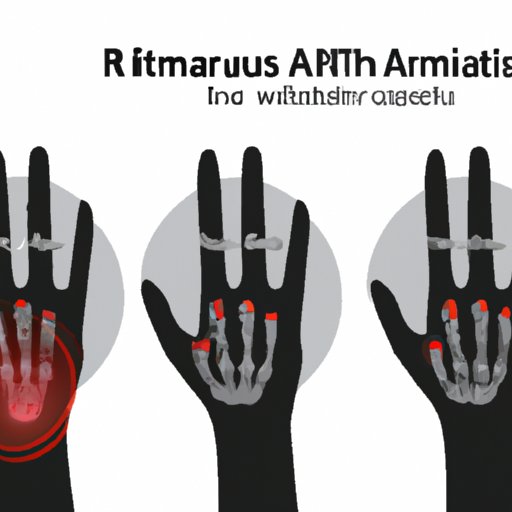
Introduction
Rheumatoid arthritis is often a misunderstood condition that impacts millions of people around the world. This chronic autoimmune disorder affects the joints, causing pain, stiffness, and swelling that can make even the simplest tasks seem impossible. In this article, we will explore the basics of rheumatoid arthritis as an autoimmune disease, and what individuals and their loved ones can do to manage the condition.
The Basics of Rheumatoid Arthritis: A Guide to Understanding an Autoimmune Disease
Rheumatoid arthritis, commonly referred to as RA, is a chronic autoimmune disorder where the immune system mistakenly attacks the joints, causing inflammation and eventually leading to the destruction of bone and cartilage. This inflammation can lead to severe pain, swelling, and stiffness in the joints, making them difficult to move.
To understand Rheumatoid Arthritis and its impact on the body, it’s important first to understand the role of the immune system. Our immune system protects the body by identifying and attacking harmful cells, organisms, and viruses. Autoimmune diseases, like RA, occur when the immune system mistakes healthy cells for invading entities and attacks them.
What Exactly is an Autoimmune Disease? A Closer Look at Rheumatoid Arthritis
An autoimmune disease happens when the immune system cannot differentiate between healthy cells and harmful ones. Instead of safeguarding the body, the immune system attacks healthy tissues and organs, causing a wide range of symptoms and complications. Scientists have not yet discovered what triggers the immune dysfunction that leads to autoimmune diseases. Still, various factors such as genetics, environmental triggers, and infection are believed to play a role.
Rheumatoid arthritis, like many other autoimmune diseases, may be triggered by a combination of genetic and environmental factors. The immune system mistakes healthy tissue in the joints as harmful and triggers an inflammatory response that causes pain and damage.
Rheumatoid Arthritis Explained: A Deep Dive into the Autoimmune Disorder
There are three types of rheumatoid arthritis: seropositive, seronegative, and juvenile idiopathic arthritis. Seropositive RA occurs when blood tests indicate the presence of rheumatoid factor (RF) and anti-cyclic citrullinated peptide (anti-CCP) antibodies. Seronegative RA, on the other hand, occurs when these antibodies are not present in the blood. Juvenile idiopathic arthritis is a type of RA that affects children under the age of 16.
When an individual has rheumatoid arthritis, their immune system attacks the synovial membrane, which lines the joints. This results in inflammation, pain, and stiffness. If left untreated, rheumatoid arthritis can spread to other parts of the body and cause significant damage to the organs and blood vessels.
There are some common risk factors associated with rheumatoid arthritis, mainly gender, smoking, obesity, family history, and age, with onset typically occurring between the ages of 30 and 60. However, RA can impact anyone, and medical professionals encourage individuals to be aware of early signs and symptoms so they can receive an accurate diagnosis and timely treatment.
From Symptoms to Diagnosis: Understanding Rheumatoid Arthritis as an Autoimmune Disease
Early symptoms of rheumatoid arthritis include fatigue, joint swelling, stiffness, tenderness, and redness. As the disease progresses, joint deformity or immobility may occur. Diagnosing rheumatoid arthritis can be conducted through a combination of blood tests, imaging and physical examination. Doctors often test for rheumatoid factor and anti-CCP antibodies, as their presence can be an indicator of rheumatoid arthritis. Imaging such as x-rays and magnetic resonance imaging (MRIs) may also be used to look for signs of joint damage.
The Connection Between Inflammation and Rheumatoid Arthritis, an Autoimmune Disease
Inflammation is our immune system’s response to injury or infection, and it is our body’s way of fighting off harmful invaders. With rheumatoid arthritis, the immune system triggers an inflammatory response, which causes the joints to become swollen and painful, making it difficult to move. Chronic inflammation is a significant contributor to the development of rheumatoid arthritis and causes long-term joint damage.
The relationship between inflammation and rheumatoid arthritis is complicated. When inflammation occurs, cytokines are released and eventually lead to joint damage. As the disease progresses, chronic inflammation can cause irreversible damage to the bone and cartilage, leaving the joint permanently altered.
Living with Rheumatoid Arthritis: Tips and Insights into Managing the Autoimmune Disease
Lifestyle changes and medications are the primary methods of managing Rheumatoid Arthritis. Individuals can reduce their symptoms by managing stress, obtaining enough rest, eating anti-inflammatory foods and exercising regularly. Additionally, medication plays a vital role in managing rheumatoid arthritis. Some commonly used medications include nonsteroidal anti-inflammatory drugs (NSAIDs), disease-modifying anti-rheumatic drugs (DMARDs), and biologic agents.
Living with RA can be challenging, making it crucial for individuals to prioritize their well-being and have access to mental health and emotional support. Living with a chronic condition can be challenging, and emotional support can make a significant difference.
Research Advances in Treating Rheumatoid Arthritis as an Autoimmune Disease
There are currently no known cures for rheumatoid arthritis. However, significant research is ongoing to advance treatment options for people with RA. Some recent breakthroughs include the introduction of targeted biologic agents, novel oral medications and stem cell therapy. In addition, researchers are also exploring the potential of personalized medicine options for treating rheumatoid arthritis, which utilizes data gathered from a patient’s DNA and lifestyle factors to tailor a personalized treatment plan.
Conclusion
Rheumatoid arthritis is a severe autoimmune condition that no one chooses to have. Early diagnosis and management can significantly improve an individual’s quality of life, reducing symptoms and joint damage. There is hope for advances in treatment choices and even a cure, but it is essential for those impacted by RA to prioritize their health and seek medical attention if needed. We hope this article has provided you with helpful information about this autoimmune disease and its management.




